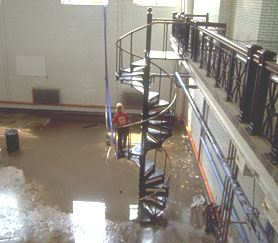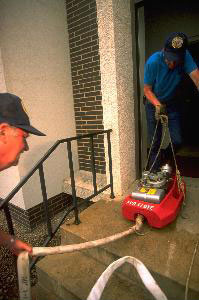Hurricane eMatrix
List of Activity Sheets » Building assessment, restoration and demolition
Removal of Floodwaters from Structures and Initial Entry into Previously Flooded Areas

This picture shows actual disaster site work conditions and may not illustrate proper safety and health procedures.
Activity Description
- This activity sheet is for response and recovery workers and supervisors involved in initial building entry and floodwater removal, regardless of their specific profession or trade.
- For some operations or situations (e.g., entry into confined spaces, using generators) other activity sheets also apply; see related activity sheets below.
- The flooding that occurred as a result of Hurricane Katrina (2005) left significant amounts of standing water. After a flood, response and recovery workers might need to enter buildings to search for and rescue survivors, retrieve critical items, perform initial inspections, and coordinate residual water removal before other response-and-recovery activities begin. Others will use fixed and portable pump systems to transfer trapped water to more appropriate locations. Initial entry in buildings and removal of standing water are likely first steps in the response to any disaster that results in widespread flooding.
- The response and recovery workers who perform these activities are typically among the first to enter previously flooded structures. They might encounter situations that have not yet received a professional evaluation to characterize the hazard.
- These individuals are also among those most likely to come in contact with floodwaters. In some areas, the water may be contaminated with fuels, oil, sewage, and other chemical or biological substances.
- Response and recovery workers conducting this operation may be employed by Federal, State, local, and private employers. Review How to Use This Matrix in the introduction for a discussion of how this information may apply to different workers.
About the Activity Sheet
This activity sheet does not provide an in-depth analysis of OSHA standards and regulations and cannot address all hazards. It does not increase or diminish any OSHA requirement or employer obligation under those requirements. It is intended as a guide and quick reference for employers and response and recovery workers. The Matrix captures major activities involved in hurricane response and recovery, highlights many of the hazards associated with them, and recommends beneficial work practices, personal protective equipment (PPE), and other exposure control methods. Employers must evaluate the specific hazards associated with the job/operation at the site where the work is being performed.
Employers are responsible for providing a safe and healthful workplace for their workers. OSHA's role is to assure the safety and health of America's workers by setting and enforcing standards; providing training, outreach, and education; establishing partnerships; and encouraging continual improvement in workplace safety and health.
The Hazard Exposure and Risk Assessment Matrix for Hurricane Response and Recovery Work provides a general overview of particular topics related to current OSHA standards. It does not alter or determine compliance responsibilities in OSHA standards or the Occupational Safety and Health Act of 1970, or the equivalent State Plan standards and requirements. Because interpretations and enforcement policy may change over time, you should consult current OSHA/State Plan administrative interpretations and decisions by the Occupational Safety and Health Review Commission and the courts for additional guidance on OSHA compliance requirements. Employers should modify their procedures as appropriate when additional, relevant information becomes available.
General Recommendations
Key Engineering Controls and Work Practices. See general recommendations document.
Personal Protective Equipment. The general PPE is recommended for all response/recovery tasks/operations; only the additional PPE that may be needed for a specific hazard is noted below.
General PPE includes:
- Hard hat for overhead impact or electrical hazards
- Eye protection with side shields
- Gloves chosen for job hazards expected (e.g., heavy-duty leather work gloves for handling debris with sharp edges and/or chemical protective gloves appropriate for chemicals potentially contacted)
- ANSI-approved protective footwear
- Respiratory protection as necessary—N, R, or P95, filtering facepieces may be used for nuisance dusts (e.g., dried mud, dirt and silt) and mold (except mold remediation). Filters with a charcoal layer may be used for odors.
Recommendations Specific to Hazards Associated with Removal of Floodwaters from Structures and and Initial Entry into Previously Flooded Areas
Key Engineering Controls and Work Practices
- Limit access/set up controlled access zones until stability and structural integrity is known
- Ensure that a competent person inspects building and floors before entry to perform work. A competent person is able to recognize existing and predictable hazardous conditions and has the authority to take prompt corrective measures to eliminate the hazardous conditions
- Install temporary structural support (shoring, bracing) adequate to protect response and recovery workers
Key Engineering Controls and Work Practices

- Assume that electrical lines are energized until proven otherwise. Lines and other conductors may become re-energized without warning as utilities are evaluated and restored after a disaster
- Inspect the work area for downed conductors and do not go near, drive over, or otherwise come in contact with them
- Downed electrical conductors can energize other objects, including fences, water pipes, bushes, trees, and telephone/CATV/fiber optic cables
- Unless deenergized and visibly grounded, maintain proper distance from overhead electrical power lines (at least 10 feet) and/or provide insulating barriers
- Do not approach any gas leaks; if a gas leak is detected, secure spark-producing devices (e.g., engines, tools, electronic, and communications equipment) and evacuate the area until the leak is secured
- Contact utility company to assist in locating, marking, and shutting off/purging utility lines that may pose a hazard or may be impacted; ensure that lines have been purged as needed before beginning work
Key Engineering Controls and Work Practices
- Remove or secure objects (glass, structural members) that may fall while workers work under them
- Use debris netting, sidewalk sheds, canopies, or catch platforms to reduce hazards from falling objects
- Verify the location of all other utility lines; ensure lines have been shut-off, capped, or otherwise controlled outside the building before beginning work. Notify utility companies before controlling their utility lines
- Assess the presence, contents, and condition of tanks and equipment that might contain hazardous chemicals, gases, or flammable materials. If the condition of tanks or equipment is suspect, avoid disturbing them until after the assessment is done and a plan of action determined
- Purge lines, tanks, and equipment containing hazardous chemicals, gases, or flammable materials. Use air monitoring equipment such as a combustible gas indicator, toxic gas monitor, or oxygen monitor to determine if any hazardous conditions remain. When necessary, provide additional controls to protect response and recovery workers (e.g., forced ventilation, respiratory protection)
- Provide and use safe walkways to reach any point without having to walk on exposed beams; walkways should be at least 18 inches wide and formed by using 2-inch thick wood, with stringers installed as needed for support
Key Engineering Controls and Work Practices
- Limit access/set up controlled access zones
- Use fall protection systems: guardrails, safety nets, or fall arrest systems
- Cover or guard holes and openings as soon as they are created. Covers must support two times the weight (body, equipment, materials) that may be imposed
Additional Personal Protective Equipment
-
Personal fall arrest system including harnesses, lanyards, lifelines, connectors, anchorages, and anchor points (as needed)
Key Engineering Controls and Work Practices
- Confined spaces have limited means of entry or exit, are large enough to bodily enter, and may contain physical (e.g., mechanical, electrical, hydraulic, pneumatic energy; engulfment hazards; inwardly converging surfaces) or atmospheric hazards (e.g., atmospheres that are oxygen-deficient or oxygen-enriched, contain or may contain flammable gas, vapor or mist, airborne combustible dust, toxic substances, or any other atmosphere that is immediately dangerous to life or health). Examples include storage tanks, process vessels, bins, boilers, vaults, ventilation or exhaust ducts, sewers, tunnels, pipelines, and pits more than 4 feet in depth
- Hurricane-related events might introduce hazards or potential hazards into confined spaces. For example, a space might have a potential to contain a hazardous atmosphere due to the presence of decomposing organic matter, to the use of hazardous chemicals in the space, or to the performance of operations in the space, such as welding, cutting, or burning, that may create a hazardous atmosphere. Additional precautions must be taken to make the space safe for entry
- During the initial entry into a previously flooded structure or one that has been sealed for an extended period of time, conduct atmospheric monitoring to detect hydrogen sulfide, an oxygen deficient atmosphere, flammables, and any other chemical that may have been stored in the structure and then released as a result of the hurricane
- Evaluate the need for entry (i.e., placing any body part into the space)
- If entry is required, see Entry into Confined Spaces activity sheet
Key Engineering Controls and Work Practices

- Reduce the exposure to splash or aerosolized liquid hazards by limiting the number of people in the area and having those in the area stay upwind of water discharge areas
- Ensure that good hygiene, especially hand washing, is practiced before eating, drinking, and smoking. If clean water is not available, use an alternative such as hand sanitizer or sanitizing wipes
- Ensure that cuts and bruises are protected from contact with contaminated water
- Clean areas of the body that come in contact with contaminated water with soap and water, hand sanitizer, or sanitizing wipes
Additional Personal Protective Equipment
- Goggles if routinely working near splashing floodwater
- N, R, or P95 respirators may be necessary for exposure to contaminated water that may become aerosolized
- Watertight boots with steel toe and insoles
- Waterproof gloves for contact with contaminated water
Key Engineering Controls and Work Practices
- Consider the potential for Asbestos Containing Materials (ACM). Structures built before 1980 are more likely to contain ACM
- If available, review the building operations and maintenance plan and ACM survey to determine the locations and types of ACM in building
- Thermal system insulation (formed or spray-on) is the ACM of greatest concern for response and recovery worker exposure
- Other materials that may contain asbestos include: vinyl floor tile, home siding & shingles, transite (including cement piping), flame retardant materials (e.g., gloves, curtains) and roof flashing
- If building is suspected or known to contain asbestos-containing thermal system insulation, ensure a qualified individual, such as a competent person, a person certified as an asbestos inspector by the State, or a safety and health professional, inspects the building and evaluates the condition of the material prior to any remediation or cleanup of ACM or PACM by other response and recovery workers
- If located, do not disturb material and isolate area until material can be visually inspected for integrity
- If removal is necessary to complete work, ACM must be removed by workers who are trained to perform the class of abatement work they will conduct, using the methods identified in 29 CFR 1926.1101. ACM must be discarded in a landfill that has a permit to accept ACM
Additional Personal Protective Equipment
-
Based on the initial exposure assessment, select a respirator and protective clothing for visual inspection, sampling, and subsequent abatement work
Key Engineering Controls and Work Practices
- Never attach a generator directly to the electrical system of a structure unless a qualified electrician has installed a transfer switch for the generator. If the structure's electrical system is not isolated, it may energize the utility's wiring system for great distances and create a risk of electrocution for utility workers and others in the area
- Always plug electrical equipment directly into the generator using the manufacturer's supplied cords or grounded (3-pronged) extension cords that are rated for the total anticipated load
- Do not overload a generator; it can overheat and create a fire hazard
- Ground and bond generators according to the manufacturer's recommendations; ensure that any manufacturer-required connections are secure before using the generator
- Keep the generator dry; protect with a canopy if needed; do not use it in wet or rainy conditions
- Carbon monoxide (CO) is a poisonous, colorless, and odorless gas that is produced by the incomplete burning of the generator's fuel. CO is harmful when breathed because it displaces oxygen in the blood and deprives the heart, brain, and other vital organs of oxygen
- Never use a generator indoors or in enclosed spaces such as garages and basements; opening windows and doors may not prevent CO from building up in those spaces. Do not use a generator outdoors near doors, windows, and vents that could allow CO to enter
- Ensure that a generator has 3 to 4 feet of clear space on all sides and above it to ensure adequate ventilation and cooling
- Before refueling, shut down the generator and allow it to cool
Additional Personal Protective Equipment
-
Hearing protection—see Noise hazard
Key Engineering Controls and Work Practices
- Inspect ladders for cracked, broken, or defective parts before use
- Do not exceed the load rating of ladders—remember that load ratings include people, tools, and equipment
- Set up ladders on stable surfaces
- Set extension or straight ladders at a 75 degree angle from the ground (1/4 foot back for every foot of rise) and provide 3 feet above an upper landing surface to ease climbing onto/descending from height
- Use non-conductive ladders (e.g., fiberglass) and exercise extreme caution when working near power lines
- Secure ladders that can be displaced by work activities; consider barricades at the base to keep traffic away
Key Engineering Controls and Work Practices
- Establish barriers/marks around areas of known hazards (holes, overhead hazards)
- Take extra care when stepping into areas that are unstable/uneven or where the surface cannot be seen
- See general recommendations document
Key Engineering Controls and Work Practices

- Stay upwind of or away from dust-generating activities, and in particular those involving crystalline silica-containing materials like concrete, brick, tile, drywall, mortar, sand, or stone. When inhaled, the fine crystalline silica particles contained in the dust can become lodged deep in the lung, which can lead to silicosis and other respiratory illnesses
- Use water spray or mist to suppress dust generation, especially during operations that may create a lot of dust, such as cutting or sawing silica-containing materials, jack hammering, impact drilling, using heavy equipment, and demolishing structures
- Avoid using compressed air for cleaning surfaces
- Sample worker exposures to silica during dust-generating activities
- Limit contact or disturbance of surfaces containing substantial visible mold growth
- See Mold Remediation activity sheet
Additional Personal Protective Equipment
- At a minimum, use respirators with N, R, or P95 filters for work with crystalline silica-containing materials (e.g., concrete, brick, tile, mortar). The use of N, R, or P100 filters may provide additional protection. Higher levels of respiratory protection may be needed for some operations (e.g., cutting concrete, sandblasting, mixing concrete)
- N, R, or P95 respirators may be used for nuisance dusts (e.g., dried mud, dirt, or silt) and mold (except mold remediation). Filters with a charcoal layer may be used for odors
Key Engineering Controls and Work Practices
-
Place generators, compressors, and other noisy equipment at a distance or behind a barrier when possible
Additional Personal Protective Equipment
-
Hearing protection when working around potential noise sources and when noise levels exceed 90 dBA. A useful "rule of thumb"—if you cannot hold a conversation in a normal speaking voice with a person who is standing at arms length (approximately 3 feet), the noise level may exceed 90 dBA
Key Engineering Controls and Work Practices
- See general recommendations document
- Be on guard for stray animals as they exhibit unpredictable or aggressive behavior
- Unless properly trained, do not attempt to take custody of animals – watch the animal from a safe distance while contacting animal rescue/control personnel
- Use insect repellent containing DEET or Picaridin on exposed skin and wear long pants and a long-sleeved shirt
- Inspect areas for nests and stray animals
- Assume all snakes are poisonous and all animals are rabid
Key Engineering Controls and Work Practices
-
If found, contact public health/mortuary personnel for removal
Key Engineering Controls and Work Practices
- If hazardous chemical containers are found or leaking materials are detected:
- Do not use spark-producing devices (e.g., engines, tools, electronic, and communications equipment) in the immediate area
- Take self-protective measures (i.e., move to a safe distance upwind) and contact hazardous material response personnel for evaluation/removal before continuing work in the area
Additional Personal Protective Equipment
-
Evaluate the need to revise protective clothing, respirator, and glove selection
Select any of the following potential hazards that can be associated with this activity in order to access relevant recommendations in the general recommendations document:
- Environmental hazards
Additional Medical Needs
- Follow medical guidance and precautions outlined in the general recommendations document.
- An asbestos-specific medical surveillance program, as outlined in 29 CFR 1926.1101(m), is required for workers working with asbestos for 30 or more days per year (1) who may be exposed at or above the permissible exposure limit or (2) who are likely to conduct Class I, II, or III asbestos abatement activities.
Additional Training Needs
- Follow general site- and task-specific training guidelines as outlined in the general recommendations document.
- Workers who will be required to remove ACM must receive asbestos training, as outlined in 29 CFR 1926.1101, for the class of work they will perform. See the general recommendations document and 29 CFR 1926.1101(k)(9) for additional asbestos-specific training information.
- Personnel who are likely to respond to an emergency involving the release or potential release of a hazardous substance (e.g., oil or gasoline, chlorine, pesticides, corrosives, other chemicals) must be trained to perform their role as outlined in the Hazardous Waste Operations and Emergency Response (HAZWOPER) standard, 29 CFR 1910.120(q)(6) or 29 CFR 1926.65(q)(6). Personnel who are likely to witness or discover a release, initiate an emergency response sequence, and take no further action must receive training equivalent to the "first responder awareness level." Personnel who will take any further action to stop or clean up the spill must receive additional training under HAZWOPER(q)(6).
Related Activity Sheets
- Assessment, Cleanup, and Repair of Structures
- Debris Collection
- Entry into Confined Spaces
- Hazardous Waste Operations and Emergency Response (HAZWOPER) Activities
Other Resources and References
- 29 CFR 1910.120, Hazardous waste operations and emergency response. OSHA Standard.
- 29 CFR 1926 Subpart M, Fall protection. OSHA.
- 29 CFR 1910.28, Duty to have fall protection and falling object protection. OSHA Standard.
- 29 CFR 1926 Subpart X, Ladders. OSHA.
- 29 CFR 1910.1001, Asbestos in general industry. OSHA Standard.
- 29 CFR 1926.1101, Asbestos in construction. OSHA Standard.
- Falls. OSHA Fact Sheet, (2016).
- Working Safely Around Downed Electrical Wires. OSHA Fact Sheet (Publication 3941), (2018).
- Using Portable Generators Safely. OSHA Fact Sheet, (2005).
- Mold. OSHA Fact Sheet, (2005).
- Respiratory Protection. OSHA Safety and Health Topics Page.
- NIOSH Respirator Selection Logic. Centers for Disease Control and Prevention (CDC), (2004).
- Procedures for Atmospheric Testing in Confined Spaces. OSHA Quick Card, (2005).
- Storm/Flood and Hurricane Response. National Institute for Occupational Safety and Health (NIOSH) Workplace Safety and Health Topic.
- Confined Spaces. OSHA Safety and Health Topics Page.

